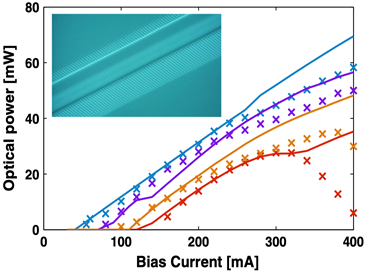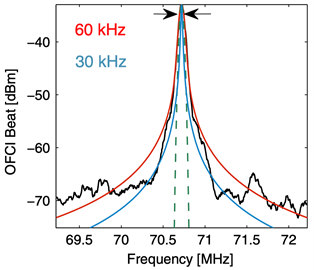Technological Physics: Nano materials and device group
"Coherent control in a semiconductor optical amplifier operating at room temperature"
A. Capua, O. Karni, G. Eisenstein, V. Sichkovskyi, V. Ivanov & J.P. Reithmaier
nature communications DOI: 10.1038/ncomms6025 (2014)

Semiconductor quantum dots (QDs) can be an ideal electronic quantum system, which can be optically addressed. However, due to the strong coupling with lattice vibrations (phonons), only low temperature operation (e.g. 10 K) is applicable. In this work room temperature operation of the coherent interaction of a driving field (photons) with electron-hole pairs in a solid state quantum dot system is shown. Due to ultra-fast spectroscopy using a frequency optical gating (FROG) technique (see figure 1), the phonon interaction can be within many field cycles completely suppressed. With a pump-probe technique, a quantum system can be prepared and the evolution observed by a delayed probe pulse with a time resolution of < 1 fs.
"Temperature stability of static and dynamic properties of 1.55 μm quantum dot lasers"
A. Abdollahinia, S. Banyoudeh, A. Rippien, F. Schnabel, O. Eyal, I. Cestier, I. Kalifa, E. Mentovich, G.
Eisenstein, J.P. Reithmaier
Optics Express 26 (5), 6056 (2018)
Due to the discretization of the energy states in quantum dots, the density of states function strongly restricts the energetic carrier distribution and allow a more efficient use of the injected carrier in a quantum dot (QD) laser. In case of sufficiently low inhomogeneous broadening of less than the energy splitting between excited and ground state transition and an energy splitting larger than the thermal energy, one can significantly reduce the temperature sensitivity of the laser performance. New record values in temperature stability could be obtained for 1.55 µm lasers using optimized QD gain material with very low inhomogeneous broadening (30 meV) and a level splitting of more than 65 meV. In figure 2, the light output characteristics of a ridge waveguide (RWG) QD laser is shown in continuous wave (cw) and pulsed operation for different heat-sink temperatures. Characteristic values for the temperature sensitivity of the threshold current density (T0) and the for the slope (T1) were evaluated to about T0 = 140 K and T1 > 900 K, respectively.

"Large linewidth reduction in semiconductor lasers based on atom-like gain material"
T. Septon, A. Becker, S. Gosh, G. Shtendel, V. Sichkovskyi, F. Schnabel, A. Sengül, M. Bjelica, B. Witzigmann, J.P. Reithmaier, G. Eisenstein
Optica 6 (8), 1071 (2019)
With the newest generation of high-quality quantum dot (QD) gain material, one can utilize basic atom-like properties in solid matter and devices made of it. In a joint collaboration between two CINSaT members (B. Witzigmann, J.P. Reithmaier) and the group of Gadi Eisenstein (Technion, Israel), we could demonstrate the strong impact of an atom-like gain material in record values of a distributed feedback (DFB) QD laser based on a 1.55 µm InP based material. The main feature of the QD material in comparison to quantum wells is the strong reduction of the linewidth enhancement factor from typically 3-5 down to zero in the ideal case. This allow a strong reduction in the emission linewidth of lasers by more than an order of magnitude. In this work an excellent agreement could be obtained between theory and experiments as shown in figure 3 (left). Record linewidth values of (30 +/- 10) kHz are obtained (see figure 3, right) at high output powers of nearly 60 mW. These results may have a big impact in the next generation of high-speed optical communications systems based on coherent transmission formats.
Fig. 3. Left: Light output characteristics for different operation temperatures (20, 40, 60, 80 °C) as measured (solid lines) and simulated (crosses); The inset show the lateral feedback gratings in 1st or-der of the DFB QD laser. Right: Measured linewidth by optical frequency comb interferometry (black) with Voigt (red) and Lorentzian line fits (blue).

[Translate to Englisch:] Bild 3-2

Prof. Dr. Johann Peter Reithmaier
full member

- Telephone
- +49 561 804-4430
- jpreith[at]physik.uni-kassel[dot]de
- Location
- Universität Kassel
Fachbereich 10 - Naturwissenschaften & Mathematik
Institut für Nanostrukturtechnologie und Analytik
Heinrich-Plett-Straße 40
34132 Kassel
- Room
- 2110
